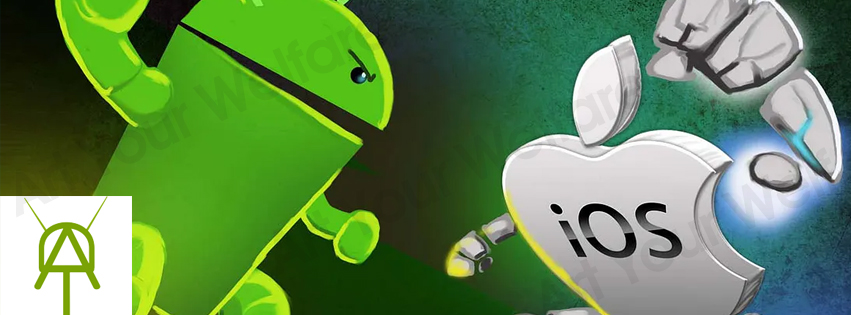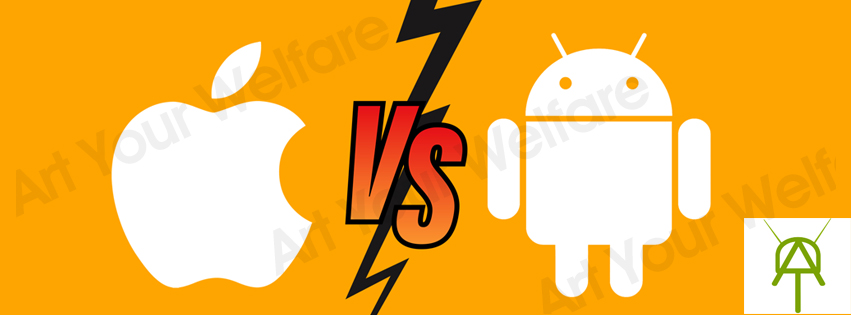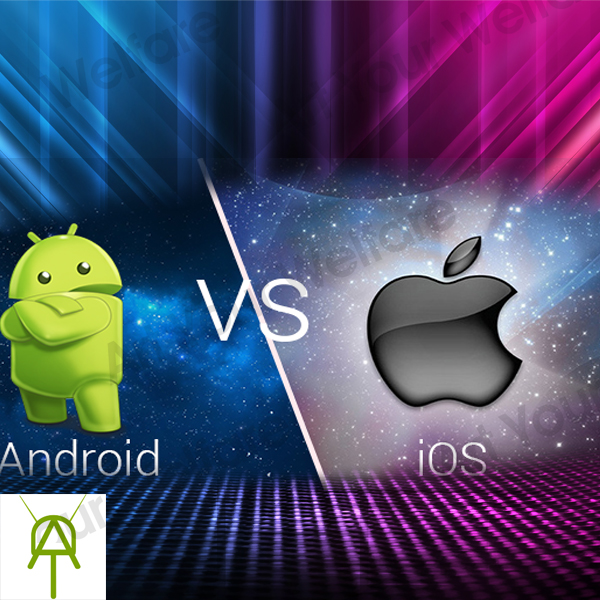Published on June 9, 2024
Mobile operating systems are the heart and soul of our smartphones. Driving everything from the user interface to the apps we use daily. Among the numerous mobile operating systems available, Android and iOS stand out as the most popular and widely used. This Android vs iOS Review aims to delve deep into these two giants. Comparing their strengths and weaknesses to help you decide which one suits your needs best. By examining various aspects such as user interface, app ecosystem. Hardware variety and security, we aim to provide a comprehensive overview of what each platform offers.
Market Share and Popularity
When it comes to market share Android vs iOS Review dominate the global landscape. But they do so in different ways as of recent statistics. Android holds a significant lead with around 72% of the global market share, thanks largely to its wide range of devices from various manufacturers. In contrast, iOS captures about 27%, a testament to Apple’s strong brand loyalty and premium device lineup. The popularity trends also vary by region; Android vs iOS Review reigns supreme in markets like Asia, Africa, and South America due to its affordability and diverse options. Meanwhile, iOS enjoys a stronger presence in North America, Western Europe, and Japan, where consumers often prioritize premium features and seamless integration with other Apple products. This diverse regional popularity underscores the unique strengths and appeal of each operating system.

User Experience
When it comes to user interface and experience, Android vs iOS Review offer distinct approaches that cater to different user preferences. Android’s UI/UX is characterized by its flexibility and extensive customization options. Users can personalize their home screens with widgets, change app icons, and even install third-party launchers to completely transform the look and feel of their device. This level of customization allows users to tailor their experience to their liking, whether they prefer a minimalist design or a feature-rich interface.
On the other hand, iOS is known for its clean, intuitive, and consistent design. Apple’s approach focuses on simplicity and ease of use, with a standardized layout that ensures a smooth and seamless experience across all iOS devices. The user interface is sleek and polished, offering fluid animations and a cohesive design language. While iOS offers less in terms of customization compared to Android vs iOS Review, its streamlined design and strong emphasis on usability make it incredibly user-friendly, especially for those who prefer a straightforward and reliable experience. This balance between customizability and simplicity highlights the fundamental differences in the UI/UX philosophies of Android and iOS.
App Ecosystem
The app ecosystem is a crucial factor in the Android vs iOS debate. With both platforms offering extensive libraries but with distinct differences. The Google Play Store, Android’s app marketplace, boasts a vast array of apps, often surpassing the Apple App Store in sheer numbers. This abundance is partly due to Android’s open nature, allowing developers more freedom and flexibility in app creation and distribution. As a result, users can find a wide variety of apps, ranging from the mainstream to the niche, catering to nearly every need and interest.
Conversely, the Apple App Store is renowned for its stringent quality control and security measures, ensuring that the apps available are reliable and safe. Although the App Store might have fewer apps than the Play Store, the focus on quality over quantity means that iOS users often experience fewer issues with malware and low-quality applications. Apple’s rigorous review process means that apps are generally well-vetted, leading to a more secure environment for users. This emphasis on app quality and security gives iOS a notable edge for users who prioritize a safe and stable app ecosystem, while Android vs iOS Review diverse and extensive app selection appeals to those who value variety and customization.
Hardware and Device Variety
One of the most significant differences between Android and iOS lies in the range of devices available. Android stands out for its incredible diversity, with devices spanning numerous brands, price points, and specifications. From budget-friendly smartphones to high-end flagship models, Android offers something for everyone. This variety not only makes Android accessible to a broader audience but also fosters intense competition among manufacturers, driving innovation in hardware features such as advanced camera systems, foldable screens, and enhanced battery technologies.
In contrast, iOS is exclusive to Apple’s tightly controlled ecosystem, with the iPhone being the sole device running this operating system. While this means fewer choices in terms of devices, it also ensures a high level of integration and optimization between the hardware and software. Each iPhone model is meticulously designed to deliver a seamless user experience, with top-notch build quality, cutting-edge technology, and regular updates. Apple’s focus on innovation is evident in features like Face ID, the A-series processors, and superior camera capabilities, setting a high standard in the smartphone industry.
Despite the limited variety, iOS devices benefit from consistent performance and a cohesive user experience. On the other hand, Android’s extensive hardware options and customization possibilities make it the preferred choice for users seeking flexibility and variety. Whether it’s choosing from a wide range of devices or enjoying the latest hardware innovations, Android and iOS each offer unique advantages that cater to different user needs and preferences.
Software Updates and Support
Software updates and support are critical aspects where Android and iOS exhibit notable differences. For Android devices, the update frequency can vary significantly depending on the manufacturer. While Google’s Pixel phones receive timely updates directly from Google, other manufacturers often lag behind, sometimes taking months to roll out the latest version of Android. This fragmentation can lead to inconsistencies in the user experience and security vulnerabilities. However, Android’s open-source nature allows for a wide range of custom ROMs and modifications, giving tech-savvy users the option to update and personalize their devices independently.
In contrast, iOS devices benefit from a more streamlined and uniform update process. Apple maintains tight control over both the hardware and software, enabling them to roll out updates simultaneously across all compatible devices. This ensures that even older models receive the latest features and security patches, significantly extending their lifespan and maintaining consistent performance. The reliability of regular updates enhances device longevity and user satisfaction, making iOS a more stable and predictable platform in terms of software support.
The impact of these update practices on device longevity and performance is substantial. iOS devices often maintain their value and usability longer due to consistent software support, which ensures that even older models remain functional and secure. On the other hand, while high-end Android devices can perform exceptionally well, the inconsistency in software updates can lead to a shorter effective lifespan for many models. Users who prioritize long-term support and regular updates may find iOS to be a more appealing choice, while those who value customization and flexibility might lean towards Android despite the variability in update frequency.
Security and Privacy
Security and privacy are paramount concerns for smartphone users, and both Android and iOS have developed robust systems to protect their users, albeit in different ways. Android offers several security features, such as Google Play Protect, which scans apps for malicious behavior, and regular security patches to address vulnerabilities. Additionally, Android’s open-source nature allows for a community-driven approach to identifying and fixing security issues. However, the diversity of manufacturers and devices means that the implementation and timeliness of these updates can vary, sometimes leaving devices exposed to risks.
iOS, on the other hand, is renowned for its stringent security measures and tight ecosystem control. Apple’s closed-source approach limits the potential entry points for malware and unauthorized access. Features like Face ID and Touch ID provide secure authentication methods, while end-to-end encryption protects data across iMessage and FaceTime. Apple’s commitment to user privacy is further exemplified by its policies, which restrict app developers from accessing user data without explicit permission. The company’s stance on privacy, highlighted by features like App Tracking Transparency, ensures that users have greater control over their personal information.
Both operating systems also have robust privacy policies in place. Android allows users to control app permissions and offers features like the Privacy Dashboard to monitor data access. Apple goes a step further with its emphasis on minimizing data collection and providing transparency about how user data is used. This approach has positioned Apple as a leader in privacy protection, appealing to users who prioritize the security of their personal information.
Integration with Other Devices
The ability of a smartphone to seamlessly integrate with other devices can greatly enhance the user experience, and both Android and iOS excel in creating robust ecosystems. The Android ecosystem is vast and diverse, encompassing a wide range of wearables, smart home devices, and more. Android users can connect their phones to smart TVs, smart speakers, fitness trackers, and a variety of other devices from multiple manufacturers. This flexibility allows users to build a customized and interconnected setup tailored to their specific needs and preferences. Google Assistant plays a central role in this ecosystem, providing a cohesive experience across different devices.
In contrast, Apple’s ecosystem is known for its tight integration and smooth continuity features. Devices like the Apple Watch, HomePod, and iPad work seamlessly with the iPhone. Creating a unified experience that is hard to match. Features like Handoff, Continuity, and AirDrop allow users to start a task on one device and finish it. On another without any hassle. For instance, users can take a call on their iPhone and seamlessly transfer it to their Mac, or unlock their Mac using their Apple Watch. Apple’s ecosystem is meticulously designed to ensure that all devices work together harmoniously, providing a seamless and intuitive user experience.
While Android’s ecosystem offers greater diversity and flexibility, allowing users to mix and match devices from different brands, Apple’s ecosystem excels in providing a consistent and integrated experience. Users who prioritize seamless connectivity and ease of use across multiple devices may find Apple’s ecosystem more appealing. On the other hand, those who value variety and customization might prefer the broader range of options available within the Android ecosystem.
Customization and Flexibility
When it comes to customization and flexibility, Android and iOS take very different approaches. Android is renowned for its extensive customization options, allowing users to personalize almost every aspect of their device. Users can change the appearance of their home screens with widgets. Install custom launchers to overhaul the entire interface, and even modify system-level settings. With root access for those who are technically inclined. This level of customization extends to app behavior, notifications, and even default applications. For various tasks, providing a high degree of control over the user experience.
In contrast, iOS offers a more curated and streamlined approach to customization. While recent updates have introduced widgets and some home screen personalization options, iOS remains more restricted compared to Android. Users can arrange app icons, use widgets in a limited capacity, and choose from a range of themes within certain apps, but the overall system customization is minimal. This design philosophy ensures a consistent and stable experience, which many users appreciate for its simplicity and ease of use.
For advanced users and developers, Android’s open nature provides a playground of possibilities. Developers can create and distribute apps with fewer restrictions, experiment with custom ROMs, and take advantage of a vast array of developer tools and resources. This flexibility has fostered a vibrant community of developers and enthusiasts who continuously push the boundaries of what Android can do.
iOS, while more restrictive, offers a robust and secure environment for app development. Apple’s stringent guidelines and quality control processes ensure that apps on the App Store meet high standards, leading to a generally more polished user experience. For developers, the iOS platform can be lucrative, given the strong purchasing power of its user base and the integrated development tools provided by Apple, such as Xcode and Swift.
Performance and Battery Life
Performance and battery life are critical factors that influence the overall user experience of a smartphone. In terms of performance benchmarks, iOS devices, particularly the latest iPhones, often lead the charts. Apple’s in-house A-series processors are renowned for their efficiency and power. Delivering smooth and responsive performance across a wide range of applications, from gaming to productivity. This level of optimization is a result of Apple’s tight integration of hardware and software, Allowing iPhones to run efficiently even with lower RAM compared to their Android counterparts.
Android devices, with their diverse range of hardware, offer a wide spectrum of performance capabilities. Flagship models from manufacturers like Samsung, Google, and OnePlus come equipped with high-end processors, such as the Snapdragon series, which deliver impressive performance and multitasking capabilities. However, performance can vary significantly across different brands and models, especially in the mid-range and budget segments. This variability is due to the fragmented nature of Android’s ecosystem, where not all devices receive the same level of optimization and support.
Battery management and optimization also highlight the differences between the two platforms. iOS is known for its effective battery management. With features like adaptive battery usage and efficient background activity control. Apple’s tight hardware-software integration allows for precise power consumption monitoring and optimization. Often resulting in superior battery life on iPhones despite having smaller battery capacities compared to some Android devices.
Android, while offering larger batteries in many models, relies on various manufacturers to implement battery optimization techniques. Features like Adaptive Battery in newer versions of Android help to extend battery life. By learning user habits and prioritizing power for frequently used apps. However, the effectiveness of these features can vary based on the device manufacturer. Their customizations to the Android operating system. High-end Android devices generally offer good battery performance. But mid-range and budget devices may struggle to match the battery efficiency of iPhones.

Cost and Value for Money
When considering cost and value for money Android vs iOS Review. Present distinct offerings catering to different segments of the market. Android devices cover a broad spectrum of price points, from budget-friendly models to high-end flagships. This diversity allows consumers to find an Android device that fits their budget and requirements. Whether they are looking for basic functionality or top-tier performance. Brands like Samsung, Xiaomi, and OnePlus offer excellent mid-range options that provide robust features and good performance without breaking the bank. This wide range of choices makes Android accessible to a larger audience, offering great value at various price levels.
In contrast, iOS devices, particularly iPhones, are generally positioned in the premium segment. Apple’s pricing strategy reflects its focus on delivering a high-quality, seamless experience across its ecosystem. While the entry-level iPhone SE offers a more affordable option. The majority of iPhones, such as the iPhone 13 and 14 series. Come with a higher price tag. However, these devices justify their cost with premium build quality. Long-term software support, and a cohesive ecosystem that includes seamless integration with other Apple products. Like the Apple Watch, iPad, and Mac.
When evaluating cost-effectiveness, it’s essential to consider not just the initial purchase price but also the long-term value. Android devices, particularly in the mid-range and budget categories. Offer excellent value for money by providing advanced features and good performance at competitive prices. However, the resale value of Android devices tends to depreciate faster compared to iPhones. iOS devices, while more expensive upfront, often have better resale value and longer software support, which can offset the higher initial cost.
Ultimately, the value proposition of each platform depends on the user’s priorities. Android’s extensive range of devices ensures that there is something for everyone. Offering flexibility and affordability iOS, while generally more costly. Provides a high-quality, integrated experience with long-term benefits, making it a worthwhile investment for those who prioritize performance, build quality, and ecosystem integration.
User Demographics and Preferences
The user demographics for Android and iOS reflect the distinct appeal and strengths of each platform. Android’s user base is incredibly diverse. Spanning all age groups and socioeconomic backgrounds due to the wide range of devices available at various price points. Android is particularly popular in emerging markets and regions where affordability is a significant factor. The platform’s flexibility and customization options also attract tech enthusiasts and users. Who appreciate having control over their device’s appearance and functionality. Additionally, Android’s open-source nature and extensive app ecosystem. Make it a preferred choice for developers and those who enjoy tinkering with their devices.
In contrast, iOS tends to attract users who prioritize a seamless. User-friendly experience and are willing to invest in premium products. The typical iOS user often falls into higher income brackets. Values the integration of Apple’s ecosystem including devices like the Apple Watch, iPad, and MacBook. Android vs iOS Review is particularly popular in North America, Western Europe, and Japan. Regions where consumers are more likely to prioritize brand loyalty, device quality, and long-term software support. The intuitive design and consistent performance of iOS devices also make them appealing. Users who prefer a straightforward, reliable experience with minimal need for customization.
Several factors influence user preferences when choosing between Android and iOS. Price is a significant consideration, with Android offering more affordable options across different segments. Customization and flexibility are also crucial for many Android vs iOS Review users who enjoy personalizing their devices. On the other hand, iOS users often prioritize security, privacy, and the cohesive ecosystem that Apple provides. The reputation of the brand, the resale value of devices. The availability of exclusive features and apps further sway user preferences towards one platform over the other.
Performance Comparison
Pros and Cons of Android
Pros: Android’s greatest strength lies in its flexibility and customization options. Users can personalize their devices extensively, from changing the look of the home screen. With widgets and custom launchers to modifying system-level settings. The vast range of devices available, from budget-friendly to high-end models. Ensures there is an Android phone for every budget and preference. Additionally, the open-source nature of Android encourages innovation and a vibrant community of developers. This openness also translates into a wider variety of apps available on the Google Play Store. Catering to niche interests and advanced functionalities.
Cons: However, Android’s diversity can also be a drawback. The fragmented nature of the platform means that not all devices receive timely software updates. Leading to potential security vulnerabilities and inconsistent user experiences. Lower-end Android devices might suffer from performance issues and lack long-term support. The customization options, while a boon for some, can also overwhelm users who prefer a more straightforward, out-of-the-box experience.
Pros and Cons of iOS
Pros: iOS excels in delivering a consistent and polished user experience. The seamless integration within Apple’s ecosystem allows for effortless. Connectivity between devices such as the iPhone, iPad, Mac, and Apple Watch. Regular software updates across all compatible devices ensure security, stability, and access to the latest features. The App Store’s strict quality control results in high-quality, secure apps. Additionally, iOS devices typically have strong resale value and long-term support, making them a good investment over time.
Cons: On the downside iOS offers limited customization options compared to Android. Which might frustrate users who enjoy tailoring their device experience. The premium pricing of iPhones and other Apple products can be prohibitive, making iOS less accessible to budget-conscious consumers. While the walled-garden approach enhances security and performance, it also restricts users’ freedom to experiment and modify their devices.

Conclusion
Both Android and iOS offer distinct advantages that cater to different user needs and preferences. Android stands out for its extensive customization options. Diverse range of devices and affordability making it an excellent. Choice for users who prioritize flexibility and personalization.
On the other hand iOS excels in delivering a consistent high-quality user experience. Seamless integration across Apple’s ecosystem regular software updates. Strong security features making it ideal for users who value reliability. Ease of use and long-term support or ultimately the choice between Android vs iOS Review. Comes down to individual priorities and what aspects of a smartphone experience are most important to the user.


